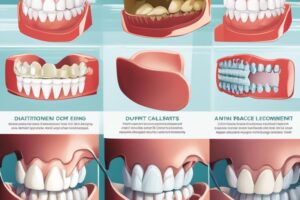Oftentimes, parents may not be aware that their child is suffering from a condition known as bruxism, or teeth grinding. This involuntary habit can have harmful effects on a child’s dental health, leading to tooth wear, jaw pain, and even developmental issues. In this informative blog post, we will discuss the signs and symptoms of bruxism in children, as well as effective ways to manage and treat this condition to ensure the well-being of your child’s oral health. Understanding the causes and appropriate management strategies for bruxism in children is crucial for parents and caregivers in providing the best care for their young ones.
Key Takeaways:
- Early Detection is Key: Identifying bruxism in children early on can lead to better management and prevention of further dental issues.
- Stress and Anxiety Can Play a Role: Children may grind their teeth as a response to stress or anxiety, so it’s important to address any underlying emotional issues.
- Customized Treatment is Essential: Each child may require a customized approach to managing bruxism, which may include dental appliances, stress-reducing techniques, and regular dental check-ups.
Identifying Bruxism in Children
Obviously, identifying bruxism in children can be a challenge since they may not be aware that they are grinding their teeth. However, there are certain signs and symptoms that can help parents and caregivers recognize this condition.
Common Symptoms and Signs
Children who grind their teeth may experience headaches, earaches, and jaw pain. They may also exhibit wear and tear on their teeth, leading to tooth sensitivity and pain. Additionally, parents may notice that their child makes a grinding or clenching noise while sleeping.
Differences Between Awake and Sleep Bruxism
One key difference between awake and sleep bruxism is that children who grind their teeth during the day may do so unconsciously, often in response to stress or anxiety. Conversely, sleep bruxism occurs during non-rapid eye movement (NREM) sleep, and children may be unaware of their actions.
Common signs of both awake and sleep bruxism include tooth wear, muscle fatigue, and disturbed sleep patterns. It is important for parents to pay attention to these signs and seek professional help if they suspect their child is grinding their teeth.
Causes of Bruxism in Children
Clearly, understanding the causes of bruxism in children is crucial for effectively managing and treating this condition. There are various factors that can contribute to the development of teeth grinding in children, including psychological and physical triggers.
Psychological Factors
One of the main psychological factors that can lead to bruxism in children is stress. Children may experience stress from various sources such as school, family issues, or social interactions. Anxiety and emotional tension are also known to be triggers for teeth grinding. Recognizing and addressing these psychological factors can help in managing bruxism in children.
Physical Factors
For some children, physical factors such as misaligned teeth or jaw position can contribute to bruxism. Abnormal bite or mouth breathing can also lead to teeth grinding. Thumb sucking or tongue thrusting are common habits that can affect the oral structures and contribute to bruxism. Though these physical factors may be out of the child’s control, addressing them with the help of a dental professional can aid in managing bruxism.
It is important to note that regular dental check-ups can help in identifying any physical factors contributing to bruxism. Thus, early intervention and treatment of any oral issues can help in managing and preventing teeth grinding in children.
Managing and Treating Bruxism
Not addressing bruxism in children can lead to serious dental and oral health issues, including enamel erosion, tooth sensitivity, and jaw pain. It is essential to actively manage and treat bruxism to prevent long-term damage to the teeth and jaws.
At-Home Care Strategies
An important first step in managing bruxism in children is to identify and eliminate any potential stressors or triggers that may be causing the teeth grinding. Encouraging relaxation techniques such as deep breathing exercises or gentle yoga can help reduce stress and alleviate bruxism symptoms. Additionally, using a warm compress on the jaw and applying gentle massage can help relax the muscles and alleviate tension.
Professional Treatments and Interventions
AtHome professional treatments for bruxism may include the use of a custom-made night guard, which is a plastic oral appliance worn during sleep to prevent teeth grinding. Additionally, dental professionals may recommend orthodontic treatment to correct misaligned teeth or provide muscle relaxants to alleviate jaw tension. Seeking the expertise of a pediatric dentist or orthodontist can help develop a tailored treatment plan for your child’s bruxism.
Plus, behavioral therapy and counseling can also be beneficial for addressing any underlying emotional or psychological factors contributing to bruxism in children. It is important to consult with healthcare professionals to determine the most effective treatment approach for your child’s individual needs.
Bruxism In Children – Identifying And Managing Teeth Grinding
On the whole, it is essential for parents and guardians to be aware of the signs and symptoms of bruxism in children in order to effectively identify and manage teeth grinding. By closely monitoring any changes in a child’s behavior and regularly visiting a dentist, early detection and intervention can help prevent long-term damage to the teeth and jaw. Furthermore, understanding the potential causes and employing various management techniques, such as stress-reduction strategies, relaxation exercises, and the use of dental appliances, can greatly aid in addressing and alleviating bruxism in children. Ultimately, the ability to identify and manage teeth grinding in children can lead to improved oral health and overall well-being for young individuals.
FAQ
Q: What is bruxism in children?
A: Bruxism in children is a condition where they grind or clench their teeth, often during sleep. It can also occur during waking hours, although less common. This can cause excessive tooth wear, jaw pain, and headaches.
Q: How can I identify if my child has bruxism?
A: Some common signs of bruxism in children include complaints of jaw pain or soreness, headaches, difficulty sleeping, and tooth sensitivity. Additionally, parents may hear the sound of grinding teeth during the night. A dental exam can also reveal signs of wear on the teeth.
Q: What are some tips for managing bruxism in children?
A: To manage bruxism in children, it is important to address any underlying stress or anxiety that may be contributing to the behavior. Encouraging relaxation techniques before bedtime, such as a warm bath or calming activities, can help reduce teeth grinding. In some cases, a custom-fitted mouthguard may be recommended by a dentist to protect the teeth from excessive wear.






